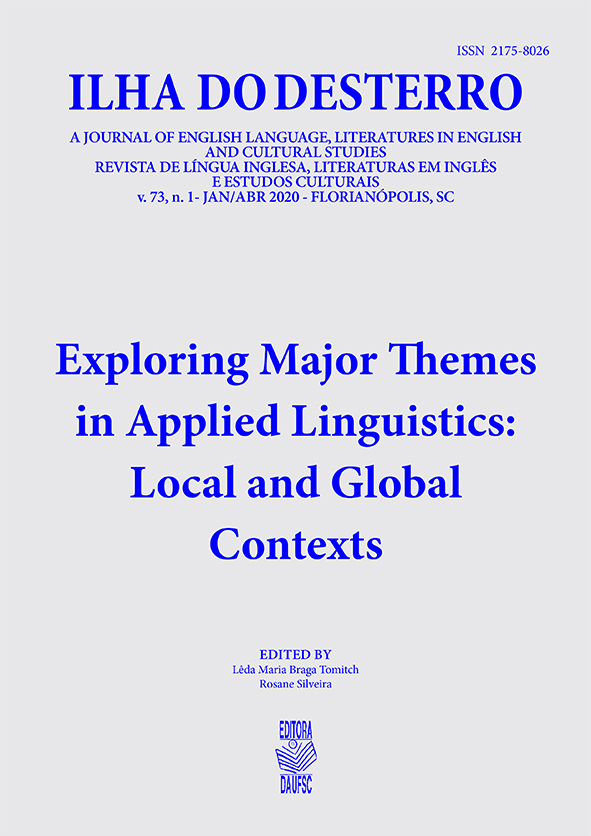Apresentando o copa-trad versão 2.0 um sistema com base em corpus paralelo para pesquisa, ensino e prática da tradução
DOI:
https://doi.org/10.5007/2175-8026.2020v73n1p297Resumo
Este artigo apresenta um sistema com base em corpus paralelo desenvolvido na Universidade Federal de Santa Catarina (UFSC) para a pesquisa, ensino e prática da tradução. O COPA-TRAD permite que o usuário investigue as práticas de tradutores profissionais através da identificação de padrões tradutórios relacionados a um determinado elemento ou padrão linguístico. Além disso, o sistema permite a comparação entre a tradução humana e a tradução automática fornecida por serviços amplamente conhecidos na Internet. Atualmente, o COPA-TRAD prevê cinco subcorpora (Literatura Infantojuvenil, Textos Literários, Meta-Discurso em Tradução, Legendas e Textos Jurídicos) e disponibiliza as seguintes ferramentas: concordanciador paralelo, concordanciador monolíngue, lista de palavras, DIY Tool que permite o usuário criar seu próprio corpus descartável. O sistema apresenta também uma interface que oferece uma ferramenta de POS-tagging que analisa e classifica as categorias gramaticais de um texto.
Referências
BAKER, M. Corpora in Translation Studies. An Overview and Suggestions for Future Research. Target, 7(2). pp. 223-243, 1995.
FERNANDES, L. P. A Portal into the Unknown: Designing, Building, and Processing a Parallel Corpus. CTIS Occasional Papers, Vol. 4, pp. 16-36, 2009.
FERNANDES, L. P. On the use of a Portuguese-English parallel corpus of children’s fantasy literature in translator education. Cadernos de Tradução, Vol. 2, No. 20, pp. 141-163, 2007.
FERNANDES, L. P. Practices of Translating Names in Children’s Fantasy Literature: A Corpus-based Study. Florianópolis, 2004. (Doutorado em Inglês e Linguística Aplicada) – Curso de Pós-Graduação em Inglês, Universidade Federal de Santa Catarina.
OLOHAN, M. Introducing Corpora in Translation Studies. Londres: Routledge, 2004.
SCOTT, M. Mapping key words to problem and solution. Patterns of Text: in Honour of Michael Hoey, Amsterdam. Benjamins. p. 109-127, 2001.
SILVA, C. E. Developing Online Parallel Corpus-based Processing Tools for Translation Research and Pedagogy. Florianópolis, 2013. Dissertação (Mestrado em Inglês e Linguística Aplicada) - Curso de Pós-Graduação em Inglês, Universidade Federal de Santa Catarina.
SILVA, C. E. Utilização de Técnicas de Mineração de Textos em Corpora Paralelo para Auxílio na Pesquisa Acadêmica em Estudos da Tradução: Um Estudo de Caso. 64 f. Trabalho de Conclusão de Curso (Especialização) – Curso de Pós-Graduação em Engenharia e Projetos de Software, Universidade do Sul de Santa Catarina, Florianópolis, 2014.
SILVA, C. E. Corpus Mining: A New Perspective on Translation Studies. Florianópolis, 2018. (Estudos da Linguagem) – Programa de Pós-Graduação em Inglês, Universidade Federal de Santa Catarina.
SINCLAIR, J. M. Corpus, Concordance, Collocation. Oxford: Oxford University Press, 1991.
VARGA, D., L. NÉMETH, P., HALÁCSY, A., KORNAI, V., TRÓN, V., NAGY. Parallel corpora for medium density languages. Proceedings of the RANLP 2005, p. 590-596, 2005.
ZIPF, G. K. Human Behaviour and the Principle of Least Effort. Cambridge: Addison-Wesley Press, 1949.
IMAO, Y. Javascript-based online concordancer, 2008. Disponível em: <http://www.ne.jp/asahi/yasu/casualconc/casualconcpages/pconc.html>. Acesso em: 9 fev. 2017.
WU, Y., SCHUSTER, M., CHEN, Z., LE, Q. V., NOROUZI, M., MACHEREY, W., & KLINGNER, J. Google’s neural machine translation system: Bridging the gap between human and machine translation , (p. 1-23). arXiv preprint arXiv:1609.08144.
Downloads
Publicado
Edição
Seção
Licença
A revista Ilha do Desterro publica artigos e resenhas inéditos, referentes as áreas de Inglês, Literaturas em Língua Inglesa e Estudos Culturais. Publica volumes mistos e/ou temáticos, com artigos e resenhas em inglês e português.
Autores mantém os direitos autorais e concedem à revista o direito de primeira publicação, com o trabalho simultaneamente licenciado sob a Licença Creative Commons Attribution que permite o compartilhamento do trabalho com reconhecimento da autoria e publicação inicial nesta revista.

This work is licensed under a Creative Commons Attribution 4.0 International License.



